|
The extremely large number of Types of valves which are now on the market make it extremely desirable that the code for each type should not merely distinguish that type from others, but should also convey certain information about the valve to any person who is familiar with the coding. The amount of information carried in a valve code is limited only by the desirability of keeping the code short so that it can easily be memorised. A system of letters and numbers is memorised rather more easily than a system consisting entirely of numbers. In addition there are 26 letters but only ten digits; codes employing letters therefore tend to be more flexible.
The information selected for the code should be that which any designer will wish to know when he is considering the possibility of using the valve in an item of equipment, for example:
- heater voltage or current;
- number and arrangement of electrodes;
- type of base;
- type of envelope;
- high or low anode resistance.
Quite a number of methods of coding valves have been used in the past, but most new valve types now on sale in this country are coded under either the American or the Mullard (or 'European') system. The Mullard system carries much useful information and has a great deal to commend it. It is also desirable that provision should be made for certain other electronic devices to be coded under normal valve codes; for instance, transistors can be coded using the Mullard valve code. The meaning of some of the more commonly used valve codes will now be considered in detail.
Mullard Code
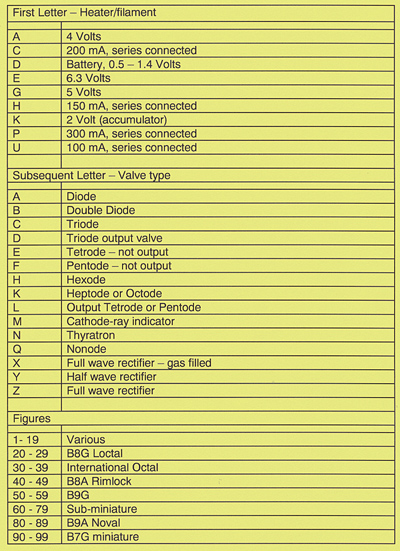
The Mullard receiving valve code system is described here and the transmitting and industrial code scheme can be found here.
The Mullard method of coding valves is also being used by some other manufacturers. The code commences with a letter indicating the heater voltage or, in the case of valves intended for use with their heaters connected in series, the heater current. If a person is designing a piece of equipment using a 6.3 Volt heater supply, he need only consider using valves whose Mullard coding begins with the letter E. A good system of valve coding therefore helps to save the time of the equipment designer.
If two or more letters follow the first letter, the valve contains more than one section in a single envelope (e.g. the ECH35 is a triode hexode).
The first digit of the number following the letters shows the type of base but the second digit is merely a sequential number which is given to distinguish between valves. which would otherwise have identical coding. If the number of the valve pins was used as the first digit of the number in an uncoded form, it would not distinguish between octal and B8A bases or between B9A and B9G bases.
The new Mullard 'frame grid' pentodes have the usual coding, but, in the cases of the EFl83 and the EF184. the code has to be extended by placing a figure 1 between the letters and the number because there are already a large number of 6.3 Volt pentodes with B9A (noval) bases.
Mullard semi-conductor valves have codes commencing with the letter O (no heater). The second letter follows the usual coding, i.e. an A for diodes or a C for transistors. A serial number follows. Modern Mullard voltage stabiliser tubes have codes commencing with the burning voltage (e.g. 150B2). The letters AW or MW followed by a serial number represent, respectively, electrostatically and magnetically focused cathode ray tubes.
American Code
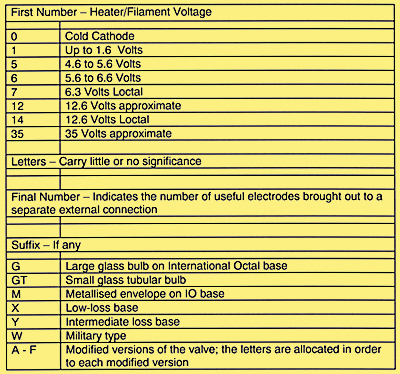
Almost all American valve manufacturers use the same (RTMA) valve code. In addition a number of valves made by certain British manufacturers (such as some of those made by Mullard and Brimar) are also marked in the American coding.
The code commences with a number which gives the heater voltage to within -0.4 to +0.6 Volts, some typical values being shown above. The 7 and 14 Volt Loctal types are mainly intended to be used in car radio equipment. They have a higher heater maximum operating voltage than the normal 6.3 and 12.6 Volt valves so that they will not be damaged by the higher voltage which is applied to their heaters whilst the car battery is being charged. It is unfortunate that the American code does not give the heater current instead of the heater voltage in the case of valves intended for series heater operation.
The first number is followed by one or two letters, these being allocated in sequence beginning with A. In the case of power rectifiers, however, the sequence commences with Z and proceeds backwards. When all of the letters have been used singly, two non-identical letters are then employed commencing with AB. If the number is followed by the letter S, the valve is a single-ended type (i.e. it does not have a top cap connection).
A further number comes next in the code. It shows the number of useful electrodes which are brought out to separate external connections. The heater counts as one electrode (unless it is tapped at a place other than the centre). An internal or external screen which is brought out to a separate connection counts as one electrode. If two electrodes are brought out to one valve pin (e.g. suppressor grid and cathode), the two together count as only one electrode for coding purposes. In almost all octal valves, pin 1 is connected to the screening, which counts as one electrode. For example, the 6J5 is a triode with a 6.3 Volt heater, the five electrodes being: anode, control grid, cathode, heater, screening. The information carried by the second number in the American code is certainly much less useful than that carried by the letter or letters following the first in the Mullard code.
Sometimes one or more additional letters are placed after the main part of the coding of octal valves, but they are often omitted. The purpose of these letters is to give some information about the external construction of the valve. For instance, the 6K8GT is a 6.3 Volt heated triode-hexode with a small bulb having straight sides, whilst the 6K8G has the same electrode structure placed in a larger glass envelope with curved sides. Providing enough space is available, the two valves are interchangeable. Many American octal valves have been made with two or more different kinds of envelope including all-metal envelopes. The meaning of any suffix placed after the main part of the coding is shown in the table above.
Gas filled voltage regulator tubes nave a code commencing with VR followed by a number indicating the normal running voltage. The final number when added to the first number gives the approximate striking voltage, e.g. VRl05/30 which strikes at 135 V and stabilises at 105 V.
Generally it can be said that the American code gives little useful information other than the heater voltage and possibly the external construction. Sometimes valves coded under the old American system are still found, especially in surplus equipment. In this code each valve is merely allocated a number which conveys no information whatsoever about the valve itself. Typical examples are the power tetrodes known as the 1622 and the 807 - the latter being a valve much used in amateur transmitters.
Marconi-Osram Code
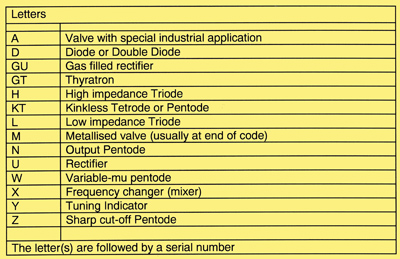
The M-OV code commences with one or more letters which are followed by a number. The letter(s) indicate the electrode structure of the valve and have the meaning shown in the table. Generally no further information whatsoever is given by the code, although in some cases the number following the letters indicates the approximate heater voltage or current. It is one of the few codes giving information as to whether a pentode is variable-mu or sharp cut-off.
Ediswan-Mazda Code
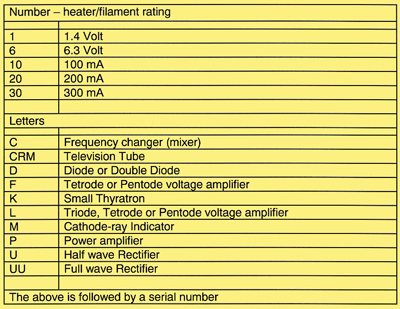
The system is very similar to the Marconi-Osram code except that it contains information about the heater. The code commences with a number indicating the heater voltage or current by means of the coding shown above, but in the case of rectifiers (e.g. UU5), this number is omitted. A letter indicating the general class of valve follows the number. The meaning of the letters is also shown in the table.
Brimar Codes
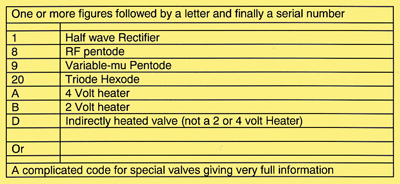
Most small Brimar valves used in ordinary radio work are coded in the American system, but two other codes are used as shown above.
STC professional valve codes can be found here.
Services Codes
The armed forces use a very great number of valves and have their own coding system. Up to 1941 the three branches of the services used valves with different codings. Those used by the Army commenced with A, the Navy with N and the Air Force with V. In surplus equipment we still find valves with such a coding as ARDD5 (Army receiving double diode number 5) or ARP3l (Army receiving pentode number 3l) - an equivalent of the Mullard EF39. The NR49 was the Naval equivalent of the EF36. The much used EF50 was known in the Air Force as the VR9l and in the Army as the ARP35.
Since 1941, however, all valves (and certain other electronic devices) used by the armed forces and government research stations have been coded under the CV (Common Valve) system. This coding consists of the letters CV followed by a number which is allocated in sequence and which gives no information whatsoever about the valve. If or instance, the CV14O is a double diode whilst the CV148 is an infra red image converter. Two or more CV numbers may be allocated to one type of valve if there are extremely slight differences in the specifications. Further letters may be added to indicate the date of manufacture.
Surplus valves which were intended for use by the American services are often marked with the normal American coding and a service coding. They usually bear the letters JAN (joint Army-Navy).
It is to be hoped that in future all valve manufacturers will mark their small radio valves with the same coding - probably the Mullard or European coding. Then it will no longer be necessary to remember that the EF91, Z77, 6AM6, 6F12 and the 8D3 all have virtually the same characteristics. Nevertheless the services will no doubt continue to know these same valves as the CV138 and its reliable version as the CV4014.
Readers may like to practice and improve their knowledge of the Mullard, Mazda, Marconi and American codes by writing down all of the information which can be obtained on the following valves from their coding. The answers may be found by following the hyper-links to the valve exhibits GZ32, X78, 1T4, 6D2, PCF80, UU8, 12AX7, KTW61, EABC80, 6SK7, N66.
|